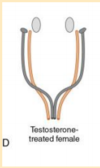12. Reproductive Embryology Flashcards
RECAP: During early embryonic development, what three germ layers arise?
- Ectoderm
- Mesoderm
- Endoderm
RECAP: what happens in the 4th week and what does it create?
- Embryo folds
- Creates a cavity inside the embryo with a gut tube suspended in it
Three tracts share a common caudal opening. What are the three tracts and what is the name of the opening?
- Reproductive tract
- Urinary tract
- GI tract
- The cloaca (the hindgut ends in this) and is closed to the ouside by cloacal membrane
What is the sequence (indifferent and different) of things forming from the primordial germ cells?
- Indifferent means the same in both males and females

What is the urogenital ridge?
- Region of intermediate mesoderm giving rise to both the embryonic kidney and the gonad
- The indifferent gonad is derived from the urogenital ridge intermediate mesoderm plus primordial germ cells (extragonadal)

What are Primordial Germ Cells?
- Common origins of spermatozoa and oocytes and thus represent the ancestors of the germline
- Arise in the yolk sac and migrate into the retroperitoneum along the dorsal mesentery

How is the gender of the foetus determined?
- The male gamete is either carrying:
- Y chromosome: XY when it combines with egg = male conceptus = primordial germ cells carry Y chromosome = Expresion of SRY genes drives development of male = gonad (testis), testicular hormone production and internal genitalia (male duct system)
- X chromosome: XX when it combines with egg = female conceptus = primordial germ cells DO NOT carry Y chromosome = absence of Y chromosome leads to development of female = gonad (ovary), internal genitalia (duct system - tubes and uterus)
What is the indifferent stage regarding the ducts?
- Mesonephric ducts develop in both male and female embryos
- Paramesonephric ducts develop in both male and female embryos
- Both ducts end at the urogenital sinus part of the cloaca

What are the fates of the ducts?
- Depend on whether there is a functional testis
- Testis produce Mullerian Inhibiting Hormone - suppress mullerian (paramesonephric) duct development. Testis producing androgens - supporting wolffian (mesonephric) duct
- No testis producing Mullerian Inhibiting Hormone - no suppression of Mullerian (paramesonephric) duct developing. No testis producing androgens - wolffian (mesonephric) duct degenerates

What happens if theres exogenous androgen development?
- supports wolffian duct
- but no testis so no MIH
- therefore mullerian ducts develop

What is androgen insensitivity hormone?
- Receptors for testosterone do not work
- Wolffian ducts don’t survive
- But MIH present so Mullerian ducts degenerate
- i.e. nothing generates
How is the male reproductive ducts formed?
- The mesonephric (wolffian) duct first acts as the duct for the embryonic kidney
- Drains into the urogenital sinus (this will become the bladder)
- Surplus to requirement once true kidney develops
- Mesonephric duct is maintained by testis derived androgens
- Converted into the vas deferens and epididymis
- Migrates with the testis as it descends
- The mesonephric duct forms the vas deferens
How are the female reproductive ducts formed? How is the uterus etc formed?
- Paramesonephric duct
- appear as invaginations of the epithelium of the urogenital ridge
- Caudally: make contact with the cloaca (urogenital sinus)
- Cranially: open into the abdominal cavity
- Paramesonephric duct forms the uterus/cervix/upper vagina/fallopian tubes

How is the uterus, cervix, fornix, vagina etc formed?

How is the indifferent stage of external genitalia formation reached?
1.
What are the basic components of the indifferent external genitalia?
- Genital Tubercle (GT)
- Genital Folds
- Genital Swellings

How does the male external genitalia form?
- The Genital Tubercle elongates and genital folds fuse to form the spongy urethra (GT develops into glans penis)
- Influence of testis-derived androgen hormones - dihydrotestosterone

How does the female external genitalia form?
- No fusion occurs in the female
- development of labia majora and labia minora
- Genital tubercle develops into clitoris
- Urethra opens into the vestibule

Describe the descent of the testis?
- Testis descend
- through the processus vaginalis and gubernaculum leading the testes into the scrotal swelling
- The processus vaginalis will then normally condense to form the tunica vaginalis
Note: gubernaculum = retroperitoneum

Picture describing descent of testis

Describe the descent of the ovary
- Gubernaculum attaches ovary inferiorly to labio-scrotal folds
- Ovary descends to the pelvis
- Uterus has developed - prevents further descent
- Round ligament of the uterus in inguinal canal
Gubernaculum becomes the ovarian ligament (connecting ovary to uterus), round ligament of the uterus (connecting uterus to labia) - round ligament occupies space in the inguinal canal
On examination, a 3 year old boy is found to have a urethral opening approximately 1.5 cm from the glans penis which extends posteriorly along the ventral surface of the shaft of the penis. What is the most likely cause of this structural anomaly?
- failure of the urogenital folds to fuse
- the penile urethra is formed as a consequence of fusion of the urogenital folds that surround the orifice of the embryonic urogential sinus. fusion of these folds and the labioscrotal folds (that form the scrotum in the male) is under the influence of testis derived androgen. the Wolffian duct develops into the vas deferens and the ureteric bud induces development of the definitive kidney and the ureter.
From which tissue do the gonads develop?
- intermediate mesoderm in the abdomen
- the gonads develop from an indifferent gonad derived from the intermediate mesoderm in the abdomen. As development proceeds, the gonad undergoes descent through the abdomen. Blood supply and venous and lymphatic drainage of the gonads reflects this abdominal origin.
The gubernaculum connects the developing testis to _________?
- the developing scrotum and in so doing creates the “pull” to guide the testis caudal through the abdomen to enter the scrotum by the end of gestation.


